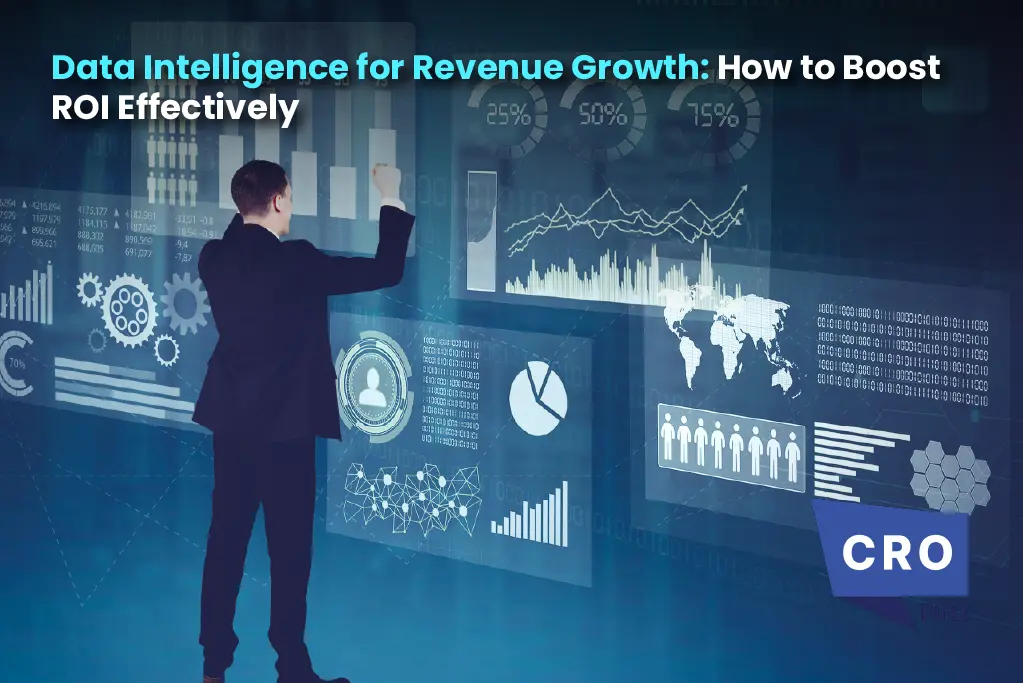Last year, countless companies missed revenue opportunities they didn’t even see coming. Customers changed. Markets shifted. Old reports only showed what already happened, leaving teams a step behind. In a world this fast, reacting is already too late.
That’s why data intelligence matters. It’s not just about collecting data from CRM, ERP, or web platforms. It’s about turning scattered numbers into insights that guide real action. Predictive models show what’s likely to happen next. Prescriptive insights suggest the moves that actually drive results.
Using data intelligence is the smartest way to spot high-impact revenue opportunities, optimize processes, and make decisions that improve ROI. Companies that master it don’t just survive, they lead.
Even on a global scale, the stakes are clear. BEA’s digital economy stats highlight how data itself shapes trade, high-tech services, and supply chains. Businesses that understand and act on this insight have a huge advantage.
Turning Data into Decisions That Matter

Looking at numbers from yesterday or trying to figure out why something happened is no longer enough. Businesses that stick to just reports are always a step behind. Sure, descriptive analytics can show trends, and diagnostic analytics can explain causes, but that only gets you so far. The real advantage comes when you can act before the market moves.
Predictive analytics will change the game entirely. Companies are able to predict trends, identify risks and discover new opportunities faster than anyone else by relying on historical data and machine learning. Just picture it, being privy to the information about which customers are likely to turn their back in the next quarter or which products will witness a sudden rise in demand. You can plan your sales moves, tweak campaigns, and even optimize pricing before it affects your bottom line.
Prescriptive analytics takes it even further. It doesn’t just give you a forecast, it tells you the next move to hit your target. The process of turning insights into actions encompasses everything from price adjustments to determining the next-best-offer for an important client. Firms utilizing prescriptive analytics are not merely responding to situations; they are opting for the moves that ultimately improve both the operational side and financial reporting straightaway.
Making this shift isn’t just about tech. Teams have to trust the data, work together across functions, and actually follow the insights. Those who do don’t just survive in the market, they shape it. Data intelligence isn’t a tool you use once. It’s a way to stay ahead, every day.
The Three Pillars of Revenue Growth Driven by Data Intelligence
Pillar 1: Identifying High-Impact Revenue Opportunities
Revenue doesn’t just appear. You have to know where to look. Pricing is the first place to start. With data intelligence, companies can figure out the right price for every product, segment, and even time. Some customers are more flexible than others. A small, overlooked group might handle a price increase without dropping demand. Spotting that early can lift revenue without scaring anyone away.
Next is understanding your customers for real. Customer Lifetime Value (CLV) modeling doesn’t just stop at the average customer prediction but also estimates the individual customers’ total revenue generators during their lifetime. This also makes it possible for you to concentrate your resources on the people that will actually matter to your business and disassociate from customers that don’t. The strategies for acquiring and retaining customers become not only more scientific but also less random.
Patterns matter too. Market Basket Analysis finds connections in purchases that humans often miss. It shows what products go well together and which cross-sell or up-sell moves work best. Next-best-offer strategies come alive here. A well-timed suggestion can turn a casual shopper into a high-value customer.
Even big-picture numbers back it up. In the second quarter of 2025, the U.S. current-account deficit narrowed by $188.5 billion, or 42.9 percent, to $251.3 billion. It’s a hint that the market is shifting. Companies who read the signs early can grab revenue opportunities others miss.
Revenue growth isn’t luck. It comes from knowing where to act, who to focus on, and what patterns to follow. Data intelligence makes that clear.
Pillar 2: Optimizing Revenue Processes and Efficiency
Revenue doesn’t grow by chance. It grows when processes run smoothly and every move counts. Take sales forecasting. Predictive models can improve accuracy, so teams know where to focus and how to allocate resources. You’re not guessing anymore. You’re planning with confidence.
Marketing spend works the same way. Multi-touch attribution models show exactly which channels are driving results. Suddenly, last-click decisions feel outdated. You can reallocate budgets in real time, favoring the channels that actually pull weight. That’s data intelligence turning insights into dollars.
Keeping customers matters just as much. Early warning systems flag people at risk of leaving before it’s obvious. Retention teams can act quickly, keeping revenue that would have slipped away. The result is smoother growth instead of constant firefighting.
Inventory and capacity management also benefit. Using predictive insights, companies can match stock levels and resources to forecasted demand. Waste drops, missed revenue shrinks, and operations hum along efficiently.
And the proof is in the impact. In 2024, Google Search, Google Play, Google Cloud, YouTube, and Google advertising tools drove $850 billion of economic activity across millions of U.S. businesses, nonprofits, and creators. It’s a reminder that smarter, data-driven decisions don’t just improve internal operations, they ripple out to the entire economy.
Digital marketing is evolving too. Google’s 2025 report stresses mastering measurement, aligning KPIs, mapping spend, and testing constantly. Companies that follow this approach get a real edge.
When revenue processes run on intelligence, every decision counts and every dollar works harder.
Also Read: Top 5 Partner Relationship Management Tools for Revenue Growth
Pillar 3: Enabling Smarter Strategic Decisions
Strategy isn’t guessing. It’s seeing what could happen and planning before things go sideways. Scenario planning lets leaders test different outcomes without learning the hard way. You can spot risks, find opportunities, and make moves with confidence.
Competitive advantage comes when you mix outside info with your own numbers. Looking at competitor pricing, market trends, and regulations together gives a full picture. You’re not just reacting to changes but you’re ahead of them.
Risk is part of the game. Data intelligence helps you figure out what’s safe and what’s worth the leap. Leaders can pick moves that balance reward with risk instead of relying on gut feeling.
The scale is huge. WEF reports digital services now make up more than half of global services exports. Companies invested $252 billion in AI in 2024. In ASEAN, the digital economy is set to double to $2 trillion by 2030. That shows those who pay attention and act on the data are the ones winning.
Smart strategy isn’t luck. It’s watching patterns, using data, and taking action before everyone else does.
Tools and Strategies for Maximizing ROI

Tools don’t grow revenue by themselves. The importance of the matter lies in the way you utilize them. Cloud-based data warehouses enable the teams to process a great amount of data without any decrease in performance. When adding visualization tools such as Tableau or Power BI, the information will be available to anybody, not just IT, who needs it, in the form of insights.
AI and machine learning platforms take it further. The predictive and prescriptive models that they assist in creating are the ones that lead to decisions in real time. It doesn’t matter if it is to predict sales, to detect trends, or to recommend the next-best-offer, the right platform turns data into actions.
But execution is the step where most companies trip. Start with projects that can show quick wins. Dynamic pricing, better sales forecasts, and churn reduction are areas where data intelligence pays off fast. Next, make collaboration real. DI isn’t just IT’s job. Marketing, Sales, Finance, and Data teams need to work together. Without it, insights sit unused.
Governance underpins everything. If data quality, access, and security aren’t clear, teams won’t trust it. And if they don’t trust it, they won’t act on it.
The numbers show the impact. Salesforce reports that 54% of consumer goods leaders say 2025 is one of the toughest years for profitable growth. Yet Salesforce’s AI-powered cloud solutions are projected to generate $948 billion in new business revenue and 5.5 million jobs by 2025. That’s proof that when the right tools meet strategy and collaboration, data stops being just numbers and starts driving real results.
Using tools wisely, working together, and trusting your data turns potential into revenue that actually shows up.
Intelligence as a Competitive Imperative
Data intelligence isn’t something you can ignore anymore. Companies that wait to react are always a step behind. The ones who get it spot opportunities early, fix problems before they hit, and make decisions that actually move the needle.
It shows up everywhere. Forecasts get sharper. Marketing spends land where they matter. Customers stick around longer. Teams can make choices with real confidence instead of guessing. That’s the difference between just running a business and actually growing it.
Looking ahead, the winners will be the ones who treat data intelligence like the engine it is. It keeps teams learning, adjusting, and staying ahead of changes. Every decision gets smarter because it’s backed by insight, not luck.
The takeaway is simple: DI isn’t optional. It’s the heart of modern revenue growth and the edge that separates leaders from followers.

